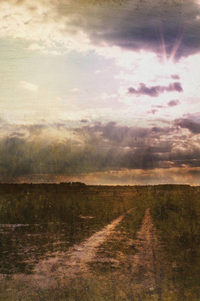Dorothy Simpson Krause: A Matter of Time

Dorothy Simpson Krause, Long Road to Sunset, 2006, UV cured flatbed print with mixed media, 48 x 32″. Image courtesy of the artist and 571 Projects.
Dorothy Simpson Krause’s ten landscapes use myriad printing techniques, mixed media and materials like salvaged copper, silver leaf and aluminum, to add heft, depth and a subtle brilliance of color. Beauty and wistfulness create a sense of nostalgia. Krause’s works are mixed media prints, derived from her own photographs, but are by no means photorealistic. Instead, the materials she uses transform the images into something more obscure but arrestingly familiar. Printed on clear film, the landscapes float just above a copper or wood surface. Krause’s underpainting increases the depth of field and enhances the sense of being there, as in the evocative Long Road to Sunset.
The exhibition’s title, A Matter of Time, references the artist’s concern with climate change. For decades, she has addressed rising sea levels and threats to our ecosystems in her work. Her marshes, dunes and rivers bear witness to the passage of time.
Over the course of a day, light alters the work, most notably when bathed in afternoon sunlight that brings a rush of oranges and reds to Krause’s coppery palette. Bare Branches, Dark Shadows, and Tarnished Trees—all 36-by-36-inches are strong examples of that effect. Light is so integral to these works it could take a year to really see them.
The 19th-century Hudson River School painters evoked the grandeur of landscape and Krause’s contemporary vision is no less majestic yet it is more intimate. After the Storm, (2004) is an inkjet print on mirror with mixed media. It elicits feelings of hope and inspiration emerging from its turbulent background. Its silver leaf frame and reflective material heighten the sense of the natural world’s capriciousness, its awe inspiring power and often elusive beauty.
Much could be written about Krause’s techniques such as UV cured flatbed printing, or her longtime artist relationship with Hewlett Packard that has given her access to high-tech, state-of-the-art equipment for experimenting. It’s difficult to categorize, or even to discern with certainty, which technique she is employing. What’s ultimately the story is the end result: her work. Krause’s process is complex but her concerns are simple: her landscapes remind us of what we have to lose.
